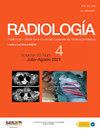Diagnóstico inicial del osteosarcoma y sarcoma de Ewing en la edad pediátrica
IF 1.1
Q3 RADIOLOGY, NUCLEAR MEDICINE & MEDICAL IMAGING
引用次数: 0
Abstract
Introduction
Osteosarcoma and Ewing sarcoma are the most frequent malignant bone tumours in children. The aim of this study is to characterize clinical and radiological features at presentation of a large cohort of children with these diseases, radiological findings useful to differentiate them and the main prognostic factors.
Material and methods
Retrospective analysis of clinical and imaging findings of 83 children diagnosed and treated of Ewing sarcoma and osteosarcoma in a paediatric hospital during a period of 10 years.
Results
Both tumours showed aggressive radiological features such as permeative or moth-eaten margins, cortical disruption, discontinuous periosteal reaction, intense contrast uptake, tumoral necrosis and soft-tissue component. They differed in their location, osseous matrix and gender predilection. Osteosarcoma occurred more frequently in the metaphysis of long bones (62%) with a blastic appearance (53%). Ewing sarcoma showed a predilection for male patients (71%), occurred in flat bones (42%) and in the diaphysis of long bones (58%) with a lytic appearance (82%). 29% of children presented with metastases at diagnosis, most frequently located in the lungs. Survival rates were 78% in osteosarcoma and 76% in Ewing sarcoma. Metastatic disease, aggressive radiological features and low percentage of tumoral necrosis after neoadjuvant chemotherapy were associated with poor prognosis (P < .05).
Conclusions
Imaging can confidently diagnose malignant paediatric bone tumours in children and may differentiate Ewing sarcoma from osteosarcoma, based on gender, location and appearance of the neoplasm. Metastatic disease, presence of aggressive radiological features and low percentage of tumoral necrosis after neoadjuvant chemotherapy were associated with poor prognosis.

儿童期尤因骨肉瘤和肉瘤的初步诊断
骨肉瘤和尤文氏肉瘤是儿童最常见的恶性骨肿瘤。本研究的目的是描述一大批患有这些疾病的儿童的临床和放射学特征,放射学结果有助于区分它们和主要预后因素。材料和方法回顾性分析某儿科医院10年来诊断和治疗的83例尤文氏肉瘤和骨原性肉瘤的临床和影像学表现。结果两种肿瘤均表现为侵袭性影像学特征,如边缘渗透或虫蛀、皮质破裂、骨膜反应不连续、造影剂摄取强烈、肿瘤坏死和软组织成分。它们在位置、骨基质和性别偏好上存在差异。骨肉瘤多见于长骨干骺端(62%),呈母细胞状外观(53%)。尤因肉瘤以男性患者为主(71%),发生于扁平骨(42%)和长骨骨干(58%),呈溶解状(82%)。29%的儿童在诊断时出现转移,最常位于肺部。骨肉瘤和尤文氏肉瘤的存活率分别为78%和76%。新辅助化疗后的转移性疾病、侵袭性影像学特征和低肿瘤坏死率与预后不良相关(P <;. 05)。结论影像学检查可准确诊断儿童恶性骨肿瘤,并可根据肿瘤的性别、部位和外观区分尤文氏肉瘤和骨肉瘤。新辅助化疗后的转移性疾病、侵袭性影像学特征和低肿瘤坏死率与预后不良相关。
本文章由计算机程序翻译,如有差异,请以英文原文为准。
求助全文
约1分钟内获得全文
求助全文
来源期刊

RADIOLOGIA
RADIOLOGY, NUCLEAR MEDICINE & MEDICAL IMAGING-
CiteScore
1.60
自引率
7.70%
发文量
105
审稿时长
52 days
期刊介绍:
La mejor revista para conocer de primera mano los originales más relevantes en la especialidad y las revisiones, casos y notas clínicas de mayor interés profesional. Además es la Publicación Oficial de la Sociedad Española de Radiología Médica.
 求助内容:
求助内容: 应助结果提醒方式:
应助结果提醒方式:


